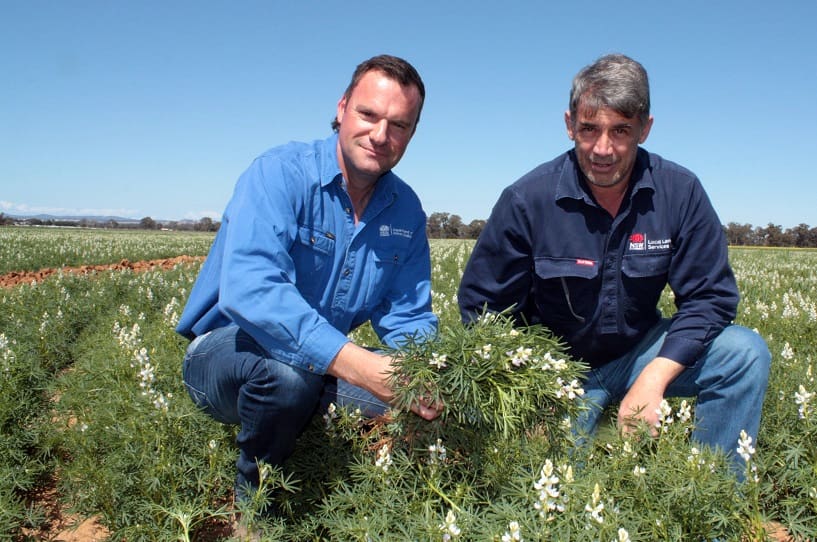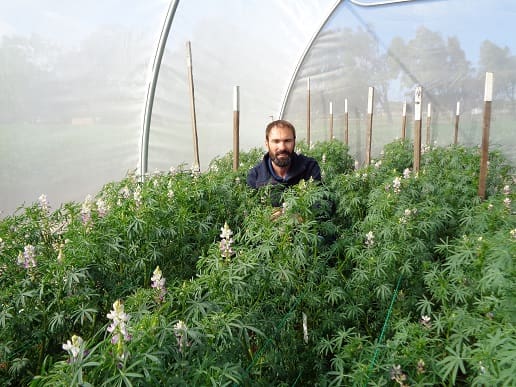
NSW Department of Primary Industries pulse pathologist, Dr Kurt Lindbeck, and Riverina Local Land Services plant health team leader, Michael Leane, inspect lupin plants as part of the plan to ensure lupin anthracnose is eradicated in NSW.
A JOINT NSW Department of Primary Industries (DPI) and Local Land Services (LLS) surveillance operation in the Riverina is helping protect the state’s $65 million lupin industry from anthracnose disease.
NSW DPI pulse pathologist, Kurt Lindbeck, said lupin crops were being inspected to ensure the devastating disease was under control and help save growers an estimated $5.5 million in annual control costs.
“Last year inspections of 100 NSW lupin crops found no evidence,” Dr Lindbeck said.
“This season’s surveillance is the third and final year of the operation to eradicate anthracnose from NSW following the 2016 outbreak, when the disease was found for the first time in NSW commercial lupin crops.
“The success of the operation to eradicate anthracnose will be a major victory for lupin producers in NSW and the eastern states.”
NSW DPI advises producers purchasing stockfeed from Western Australia and South Australia request a vendor declaration stating the feed does not contain lupin plant material, which is prohibited from entry into NSW due to the risk of introducing anthracnose.
The surveillance operation is part of the eradication plan which was put in place in 2016, when six farms in the Cootamundra-Gundagai, Coolamon and Junee shires were confirmed to have anthracnose.
The initial infection was isolated and controlled, and the three shires remain subject to restricted conditions under a biosecurity zone to control lupin anthracnose until the zone is declared free of the disease. Residents of these shires are not permitted to grow ornamental lupin plants.
Report lupin anthracnose symptoms to NSW DPI, 1800 084 881.
Fast harvest to cut grain losses and optimise quality
Meanwhile, Western Australian grain growers are advised to harvest their lupin crops as soon as they ripen to avoid grain losses from seed shedding and pod drop.
Seed shedding, pod drop, shattering of mature grain and potential for reduced seed germination (if there is rainfall after the crop matures) are key issues to be considered at this time of year.
Harvesting the crop when it is ripe can help to reduce the risks of yield losses and lower grain quality stemming from these problems.
Trials carried out in WA’s northern grainbelt in 2017, with Grains Research and Development Corporation (GRDC) investment, found delaying harvest by two weeks after crop maturity lowered average lupin yields by 6 per cent.
If the gap stretched out to six weeks after crop maturity, average yields were 15 per cent less than the crops harvested at maturity.
Department of Primary Industries and Regional Development (DPIRD) research officer Martin Harries said the extent of yield loss if harvest was delayed was similar for all six lupin varieties tested, including the latest-released lines.
“Many WA growers are adding lupin back into their rotations and, to help with decision making, we need to generate more information about the effects of delaying harvest on yield losses and potential grain damage, especially if there is rainfall after the crop has matured,” he said.
“The best harvesting window for lupin across WA’s grainbelt is typically within three weeks of crop maturity and as soon as grain moisture content reaches 14 per cent, which is the maximum allowable moisture level to meet CBH Group receival standards.
“Delaying harvest can cause seed and pods to drop and/or lead to brittle grain that is susceptible to cracking and splitting.”
DPIRD trials at Eradu, near Geraldton, last year investigated six lupin varieties and three harvest times, ranging from crop maturity to six weeks after maturity, to assess the amount of seed and/or whole pods that shed – or fell – from the plants.
Overall, average yields of the newer varieties across all harvest times were up to 0.5 tonnes per hectare (26pc) higher than the 2.5t/ha average yield across all varieties and harvest times.
A two-week delay in harvest after crop maturity resulted in an average 0.04t/ha (6pc) yield loss across all varieties. Delaying harvest by six weeks after the crop ripened caused a more significant drop of 0.3t/ha (15pc) in average yields.

DPIRD research officer Martin Harries in a lupin glasshouse trial comparing new and older varieties. (Photo: DPIRD)
Mr Harries said seed shedding or pod drop in the crop was minimal before harvest, with most yield loss occurring during the lupin harvest operation.
“All varieties had average yield losses between 12 and 15 per cent if harvest was delayed after the crop ripened, compared to if they had been harvested at maturity,” he said.
“One of the older varieties had 290 kg/ha of seed on the ground six weeks after maturity, compared to 360 kg/ha for a new line.
“This means growers should keep in mind that they face losing more grain by delaying the harvest of higher-yielding varieties.”
Mr Harries said delaying harvest after crop maturity also risked lowering lupin grain quality if rainfall occurred.
“Rain received after the crop ripens can cause the seed to wet up, which stimulates the germination processes until the seed dries again,” he said.
“This is known to exhaust the seed energy reserves and can create problems with germination rates if retaining seed for next year’s crop.”
Other work by DPIRD, involving field and laboratory trials and conducted as part of the same GRDC investment project, exposed lupin crops to simulated rainfall using overhead irrigation and subjected lupin pods to moisture and drying cycles.
These found the equivalent of just 6 millimetres of rainfall after crop maturity could reduce seed germination rates by 5-10pc.
“Where there were two wetting and drying cycles in the laboratory, seed germination rates were 10-20 per cent lower than seeds not exposed to moisture and with three wetting and drying cycles, germination levels were 35-45 per cent lower,” Mr Harries said.
“There was minimal difference between the response of different varieties to moisture and the key message is that, regardless of variety, it is advisable to harvest lupin crops as soon as possible after maturity to minimise grain losses and optimise quality.”
Sources: NSW DPI, DPIRD
More information:
The impact of delayed harvest on lupin, http://bit.ly/2O7uQI9
Full results from the simulated rainfall trials, http://bit.ly/2pyWXC1
Lupin GrowNotes, https://grdc.com.au/GN-Lupin-West
Grain Central: Get our free daily cropping news straight to your inbox – Click here



HAVE YOUR SAY